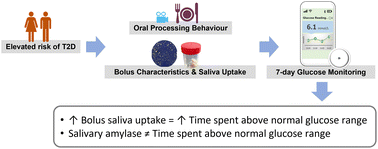Associations between oral processing, saliva, and bolus properties on daily glucose excursions amongst people at risk of type-2 diabetes†
Abstract
Background: A greater time spent with glucose above the normal range (TAR) has been associated with poorer glycaemic control amongst pre-diabetic individuals. Individual differences in oral processing behaviours and saliva amylase activity have been shown to influence glucose responses. Objective: The current study is a preliminary exploration of the associations of oral processing behaviours, bolus characteristics, and salivary amylase activity with the variability in daily glucose excursions within a free-living setting in populations with an elevated risk of type-2 diabetes. Method: Participant oral processing behaviour was derived from video recordings while they consumed a test meal. Post-meal bolus characteristics and saliva properties were measured. Participants were fitted with a continuous glucose monitor (CGM) which monitored blood glucose fluctuation over 7 consecutive free-living days. Dietary intake was recorded through a smartphone application and physical activity was monitored using a wrist worn accelerometer. Results: Participants varied in daily time spent with glucose above the normal range (>7.8 mmol l−1) from 0% to 15%. Greater saliva uptake in the bolus was associated with a higher time spent above the normal range for glucose (β = 0.067 [95% CI = 0.015, 0.120]; p < 0.05), which remained significant after adjustment for dietary carbohydrate intake and BMI. Salivary amylase and saliva flow rate were not significantly associated with the time spent above the normal range. Conclusion: In addition to conventional dietary factors, more research is needed to understand how eating behaviours such as oro-sensory exposure, bolus surface area, and saliva uptake contribute to daily variations in postprandial glucose excursions among populations with a higher risk of developing type-2 diabetes.

- This article is part of the themed collection: Food structure, sensory perception, and nutrition


 Please wait while we load your content...
Please wait while we load your content...